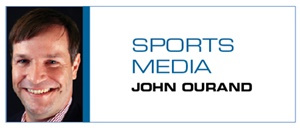At first, it felt like a gimmick when
Fox Sports went to the Cotton Bowl’s first commercial break during its Jan. 4 telecast.
Rather than going to a traditional commercial break, Fox went to a “double box.” It put live video from the stadium — shots of cheerleaders, bands, coaches, etc. — in a small box in the upper right-hand corner of the screen. In a larger box that took up about two-thirds of the screen, GM ran a traditional 30-second ad. GM’s logo and sponsor message ran as a “skin” along the bottom of the screen. Allstate, Subway and Dr Pepper also ran commercials in that format during the first-quarter ad break, while Fox featured four different advertisers in the same format during a break in the second quarter.
The idea is to keep fans engaged during commercial breaks. With countless options and the presence of second screens, networks and advertisers always are looking for ways to keep viewers’ interest during ad breaks. In the past, several networks have used a similar format during NASCAR races when there are not natural breaks in the action. But this marked the first time a network used the double-box format when a sports event went to a timeout.
 |
The double-box format gives the sponsor most of the real estate but keeps live video from the event visible.
|
That’s one of the reasons why Fox’s Cotton Bowl effort felt like a gimmick, at least initially. Video from the stadium during timeouts is not compelling. Viewers want to see the NASCAR race during double-box commercials. But a timeout during a football game? That’s boring.
While it took time to get used to the concept, the more I talked to advertising executives last week, the more I became convinced that this double-box feature is the future of TV advertising, even during football games.
Fox Sports executives described the Cotton Bowl as an experiment and said they won’t be able to determine its success until they see minute-by-minute TV ratings from Nielsen. Fox will use it again for two or three commercial breaks during a UFC telecast Jan. 26 and at times during the upcoming NASCAR season. Advertisers are interested, and Fox plans to talk with MLB and the NFL to gauge interest in rolling it out during their games, too.
“We’re bullish on the future of this,” said Bill Wanger, Fox Sports’ executive vice president of research and programming. “The impetus for us to do this is because we are always looking to enhance the value of the advertising and viewing experience.”
When I discussed the Fox ads on Twitter during the Cotton Bowl, most seemed to like it. The main complaint dealt with Fox’s video, which was not compelling enough to keep viewers from channel surfing.
That’s where this format gets tricky. ESPN has used it during some of its motorsports coverage since 2005, and its executives say their research shows that video that is too compelling could take the viewers’ focus away from the ads.
“There is a cognitive load that people are able to process,” said Barbara Singer, ESPN’s vice president of advertiser insights and research. “You have to be careful how much you’re putting in front of them.”
Networks and advertisers will become savvier about tailoring their messages to this new format. Advertisers are interested in anything that keeps viewers from channel surfing, even if it means giving up some of the screen. To date, advertisers are paying the same rate in a double-box format, though that could change.
Fox started testing the double-box format in the spring of 2011, showing picture-in-picture commercials during the final three NASCAR races on its schedule that season.
Afterward, Fox Sports commissioned research from Innerscope that showed that the double-box commercial breaks ranked 18 percent higher on engagement than full-screen ads. Fox found that 84 percent of viewers liked the double-box ad format better than the traditional full-screen ads.
“We’re finding that it’s a more engaging and effective way to show commercials,” Wanger said. “The process is evolving. We are learning as we go. There’s a wide open canvas for what we can do.”
John Ourand can be reached at jourand@sportsbusinessjournal.com. Follow him on Twitter @Ourand_SBJ.





